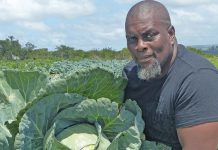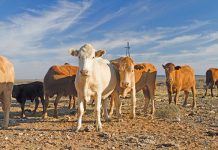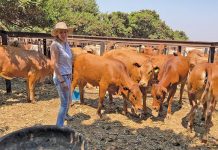
Photo: FW Archive
The Valsrivier Bonsmara Breeders Group, which comprises two stud and three commercial breeders, was started in 2005 by Cornay Botma (Hentacor Bonsmaras) of Bothaville and WH van Zyl (Thuso Bonsmaras) of Wesselsbron.
The latter has, in the meantime, been taken over by WH’s son, Thabo. The three commercial breeders are Danie Minnaar of Kroonstad, and Chris Joubert and Japie van der Berg, both of Bothaville.
Botma recalls that at the time of the launch, he and WH had been running their stud concerns for 15 and 22 years respectively.
“We were reliant mainly on club auctions and out-of-hand sales at that stage, but after careful consideration, decided in 2005 on our own production auctions. This decision was taken after in-depth research and widespread consultations.
“The objective was, and remains, to showcase the genetic integrity, quality and value-adding ability of the animals produced by the group. Economics obviously formed the bottom line of our decision.”
Making financial sense
Thabo van Zyl points out that auctions are expensive, and the group auction set-up clearly makes financial sense, as the costs are shared amongst the members. An added cost-saver is the fact that all the members’ operations are relatively close to the auction venue on Botma’s farm, Gladdedrift. The workload, too, is shared equally, reducing the stress on each member.
Yet another factor driving the launch of the Valsrivier group was that individual members did not have sufficient animal numbers to warrant a full-scale auction by themselves.
“Over the years, we’ve merged into a well-oiled team, with each member knowing exactly what’s expected of him,” says Van Zyl. “It’s our vision to offer cattle that are true to form according to Bonsmara breed standards, which will add value to both commercial and stud breeding concerns.
“The respective members’ animals clearly differ from each other’s, but this increases the prospective buyers’ options for acquiring breeding material for different production conditions and requirements.”
The first Valsrivier Bonsmara Group auction was held on 20 April 2006 with 32 SP bulls,
30 SP cows and 300 commercial cows in all stages of production.
These numbers have remained relatively stable, although the members soon realised that there was greater demand for commercial cows than for SP cows, and therefore decided to concentrate on the former.
The number of animals put up for the annual sale (always in the third week of April) varies somewhat from year to year, but the group’s objective is to auction off about 35 SP bulls and 250 commercial cows annually. As with all group auctions, Valsrivier aims to offer its buyers enough animals to choose from so that they can meet the needs of their operations.
Organisation and planning
A plethora of factors need to be considered when planning an auction, says Botma. These include the distance that prospective buyers are prepared to travel to the auction site, the number of animals on sale, the baseline turnover that must be achieved to break even, the duration and time of the event, and the availability of infrastructure.
“Demand for Valsrivier’s Bonsmaras has grown considerably over the years.
“We’re in the process of including two more group members to strengthen the dynamics of our auction even more. While financial gain always underpins an auction, we value integrity, honesty, ethical business principles and the provision of the best possible genetics for our buyers. A group that can’t agree on and commit to these principles will find it a huge challenge to remain sustainable and profitable in the long term,” he says.
The group has no immediate plans to expand beyond the addition of the two new members. According to Botma, making the group too big could lead to an oversupply of animals and, as a result, unnecessary competition between the members. However, as with the Van Zyls, it is foreseen that some of the current members’ children will, in time, take over the businesses.
Analysis and planning are crucial to the Valsrivier group’s annual auctions. Immediately after the auction is over, the members discuss issues such as attendance numbers, prices achieved, and practical challenges experienced.
They then spend the next three weeks or so on follow-up engagements with buyers pertaining to the delivery of the animals, any problems the buyers might have experienced, and feedback on the animals sold. The members then meet for an in-depth evaluation of the event. Planning for the next auction takes place in January, and then the hard work begins.
Calendar
The choice of the third week of April as an auction date was more or less unplanned. Botma explains that at the time of the group’s first auction in 2006, the auction calendar was already nearly full, and the only opening they could find was in the third week of April. The auction has been held in that week ever since.
This has its pros and cons. On the one hand, in a grain production area such as the north-western Free State, farmers’ cash flow is somewhat limited; on the other, the grain production season has come to an end and harvesting is still far off, allowing prospective buyers to concentrate on the livestock components of their businesses.
Having an auction in late summer also means that the cattle are usually in an excellent condition because of the abundant grazing available (barring a drought, of course). This saves considerable feed costs in getting the animals ready for auction. Most of the members plan their breeding seasons so that highly sought-after three-in-one cows are put on offer.
Being sold in April also gives the animals enough time to adapt to their new conditions before the next summer breeding season starts.
“The animals recommended by the breeders for the auction are evaluated by the group’s adviser, Hennie Snyman, an animal scientist from Parys, who has the final say on which animals are allowed or not,” says Botma.
“It’s also his responsibility to divide the animals on offer into lots. Homogenous lots are crucial to quality control, and Hennie objectively evaluates the animals, putting only the best up for sale.”
The animals are usually delivered to the venue on the day before the auction. According to Snyman, this can be fairly challenging, and the best option is to have the animals in the kraals by no later than midday to allow prospective buyers ample time to view them. They are moved to the veld at about 4pm so that they can rest and graze.
Before sunrise the next day, they are moved back to the viewing kraals, separated into lots and penned accordingly, ready for the auction.
Documentation
Catalogues form an integral part of an auction. The bull catalogue is compiled according to the standards set by the Bonsmara Cattle Breeders’ Society of South Africa. To make these often-technical catalogues easier to understand, the society has decided on a new simplified format from this year that will include only the most relevant information required by the buyer to make an informed choice.
Snyman, who compiles the catalogue for the group’s commercial cattle, highlights features such as lot number, seller, age and reproductive status. Identification tags are left on the commercial animals to ensure traceability.
Live vs online auctions
According to Minnaar, the COVID-19 pandemic had a marked impact on the auction industry.
“The declaration of the state of emergency in March 2020 happened only about one month before we were supposed to hold our auction. And the playing field changed constantly; an hour before the auction, we still didn’t know whether we’d be allowed to continue or not.
Were it not for the online auction option, we’d have been left in the lurch because we were allowed only 50 people at the auction. Since then, we’ve continued to augment the auction with an online option.”
Minnaar adds that although the online auction has extended the group’s client base considerably, it is “highly unlikely” that it will replace the live event. This is simply because a considerable number of buyers prefer to see the animals, inspect them physically and evaluate them from different angles. To make this evaluation easier for online buyers, the Valsrivier group provides additional video material, supported by extended and detailed after-sales services.
Botma, Van Zyl and Minnaar are in agreement that for any auction to be a success, it must be underpinned by meticulous planning, integrity, quality, continuity, adherence to animal health protocols, and good after-sales services.
Email Cornay Botma at [email protected], or Thabo van Zyl at [email protected].













